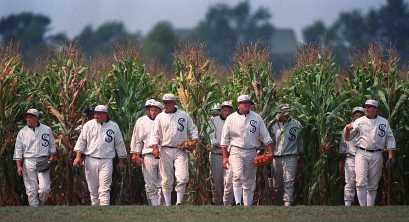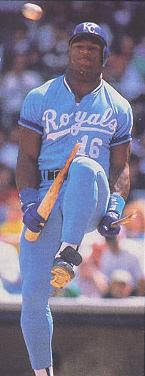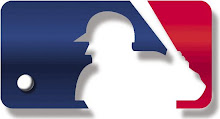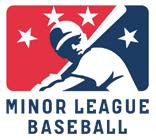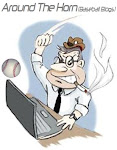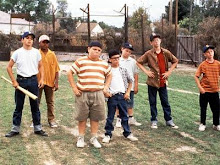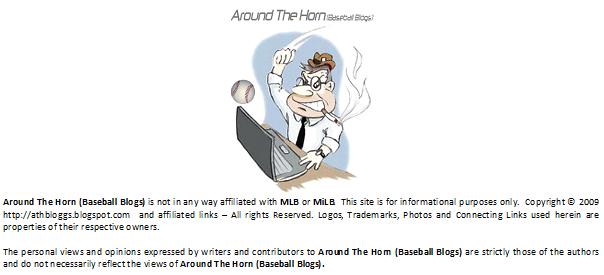 July 24, 1983 - Yankee Stadium, Bronx, New York
July 24, 1983 - Yankee Stadium, Bronx, New York
The Royals were trailing 4-3 with two outs in the top of the ninth and U. L. Washington on first base. George Brett connected off Yankee reliever Rich “Goose” Gossage for a two-run home run and a 5-4 lead. As Brett crossed the plate, New York manager Billy Martin approached rookie home plate umpire Tim McClelland and requested that Brett's bat be examined. Earlier in the season, Martin and other members of the Yankees had noticed the amount of pine tar used by Brett, but Martin had chosen not to say anything until the home run. One of the Yankees, third baseman Graig Nettles, recalled a similar incident involving Thurman Munson in a 1975 game against the Minnesota Twins. According to Nettles' autobiography, Balls, Nettles claims that he actually informed Martin of the pine tar rule, as Nettles had previously undergone the same scrutiny with his own bat while with the Twins.
With Brett watching from the dugout, McClelland and the rest of the umpiring crew inspected the bat. Measuring the bat against the width of home plate (which is 17 inches), they determined that the amount of pine tar on the bat's handle exceeded that allowed by Rule 1.10(b) of the Major League Baseball rule book, which read that "a bat may not be covered by such a substance more than 18 inches from the tip of the handle."
McClelland searched for Brett in the visitors' dugout, pointed at him, and signaled that he was out, his home run nullified and the game over. An enraged Brett stormed out of the dugout to confront McClelland, and had to be physically restrained by Kansas City manager Dick Howser and his teammates. (As one commentator stated, "Brett has become the first player in history to hit a game-losing home run.") Despite the furious protests of Brett and Howser, McClelland's ruling stood.
The Royals protested the game ("TAR WARS!" blared a New York Post headline), and their protest was upheld by American League president Lee MacPhail. MacPhail (who coincidentally had once been the Yankees' chief executive) ruled that while the bat was illegal, it didn't violate the "spirit of the rules." He added that the bat was not "altered to improve the distance factor," and that the rules only provided for removal of the bat from the game, not calling the batter out. The reason for the restriction on pine tar on bats is not because the substance gives a batter an unfair advantage, but because contact with baseballs would render the balls unusable, thus requiring more balls to be used in a particular game.
MacPhail ordered the game resumed with two out in the top of the ninth inning with the Royals up 5-4. He also ruled that Brett was to be ejected for his outburst.
The Yankees made one last appeal, but to no avail. On August (a scheduled off day for both teams), the game was resumed from the point of Brett's home run, with about 1,200 fans in attendance. On paper the scoring of the incident reads as follows: a home run for Brett, on the play Brett, Gaylord Perry, Rocky Colavito, and manager Dick Howser were ejected, game suspended with two outs in the top of the ninth.
A still furious Martin symbolically protested the continuation of the game by putting pitcher Ron Guidry in center field and first baseman Don Mattingly at second base. Mattingly, a lefty, became the majors' first southpaw second baseman since Oakland’s Gonzalo Marques a decade earlier; there has been one only lefty middle infielder in a big-league game since That Bosley in 1987.
Before the first pitch to Hal McRae (who followed Brett in the lineup), Martin challenged Brett's home run on the grounds that Brett had not touched all the bases, and maintained that there was no way for the umpires (a different crew than the one who worked July 24) to dispute this. But umpire Davey Phillips was ready for Martin, producing an affidavit signed by the July 24 umpires stating that Brett had indeed touched all the bases. An irate Martin continued to argue with the umpires and was ejected from the game. As he exited the umpires announced that the game was being played under protest by the Yankees. Yankees reliever George Frazier struck McRae out to finally end the top of the ninth, twenty-five days after it had begun. Dan Quisenberry then got New York out 1-2-3 in the bottom of the ninth to preserve the Royals' 5-4 win.
 July 14, 1970 - Riverfront Stadium, Cincinnati, OH
July 14, 1970 - Riverfront Stadium, Cincinnati, OH
